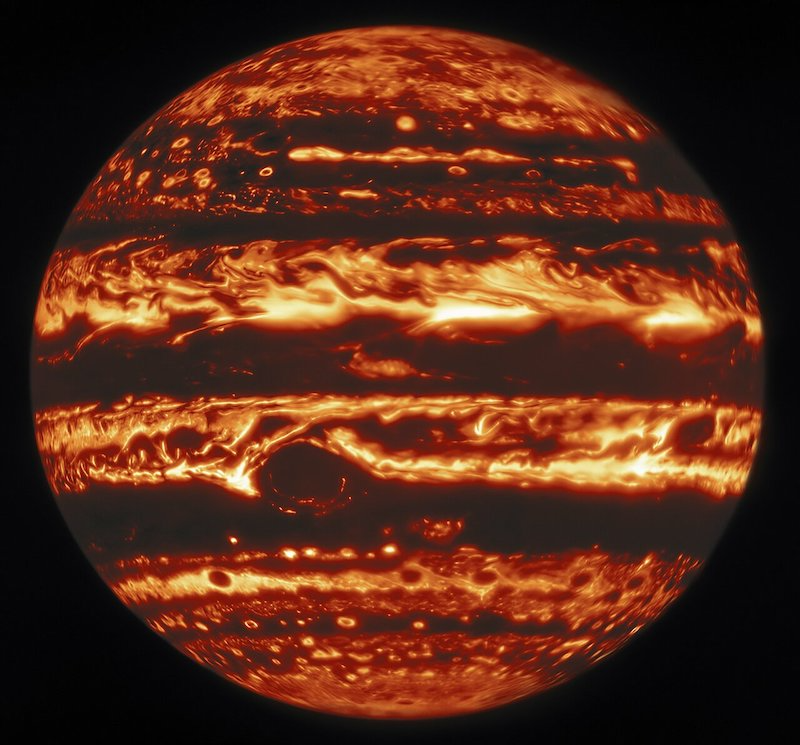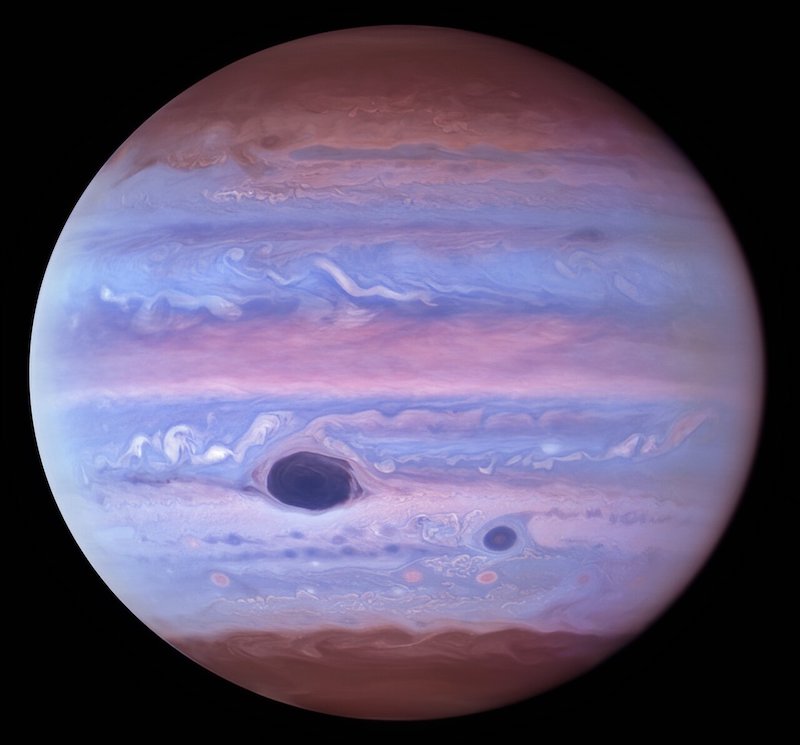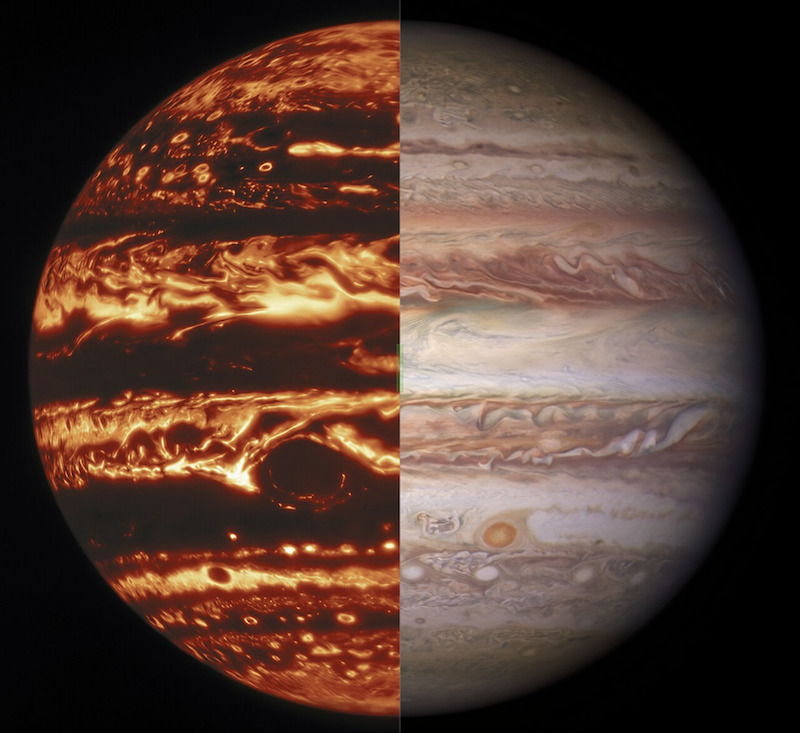With its multicolored bands of swirling clouds, Jupiter is one of the most beautiful sights in the solar system. Spacecraft – including NASA’s Juno spacecraft, currently orbiting the giant planet – have sent back jaw-dropping views of this world. This month (May 11, 2021), scientists released some stunning new images from the Gemini North telescope in Hawaii and the Hubble Space Telescope, showing Jupiter in infrared, ultraviolet and visible light. Though they were taken from Earth and Earth-orbit, they show striking detail in Jupiter’s tumultuous clouds.
Although no new peer-reviewed paper is associated with this release, the images and data are the subject of two previous papers, from 2019 and 2020. They are also featured in a new blog post at NOIRLab by Gemma Lavender.
The new research was led by Mike Wong at the University of California. Heidi Hammel at the Association of Universities for Research in Astronomy (AURA) described his work, saying:
What’s really cool about the work that Mike has been doing – by combining the Hubble observations with those from Gemini and the Juno spacecraft – is that it’s a really powerful example of how using different tools in our arsenal is a far more powerful way to study planetary objects than just picking one alone.
Apart from being striking visually, the images help astronomers study Jupiter in various wavelengths of light. This can bring out details that might otherwise be missed.

The visible light and ultraviolet images came from Wide Field Camera 3 on Hubble, while the infrared image was taken by Gemini North. The images can be accurately compared directly, since they were all taken simultaneously at 15:41 UTC on January 11, 2017.
One of the main features studied in the images is, of course, the famous Great Red Spot. The spot is a very long-lived storm in the atmosphere that, although shrinking a bit in recent years, is still much larger than Earth itself. Interestingly, it is almost invisible in infrared, but shows up clearly in the ultraviolet and visible light views. The cloud bands around are visible in all three images.
The Great Red Spot has been studied since the 1600s, but the new images did reveal some surprises. It appears as a dark region in the infrared image, but that region is larger than how it looks as a reddish oval shape in the visible light image. Why the difference? Basically, different wavelengths of light will show different structures in the cloud and storms. Thick clouds tend to show up in the infrared image, but in the ultraviolet and visible light ones, we see suspended particles called chromophores. It is these particles that make the Great Red Spot look red.
The researchers also found that, in infrared, the Great Red Spot appeared to have a lot of holes in it. Wong said:
The closest analog is eddies in the ocean. As the storm clouds spin, you can get little anomalies from these eddies that form streaks by just winding up. And that’s kind of the shape that we’re seeing in these holes. So it’s probably just some weak turbulence, but as it spins, it gets stretched out.
Another feature that stands out in the infrared image is a massive, bright cyclonic vortex formation in the northern hemisphere, extending east to west for 72,000 kilometers (about 45,000 miles).

NASA’s Voyager spacecraft also saw these elongated features, and they were nicknamed brown barges. This barge in the new images looks dark brown in the visible light image, but can hardly been seen in the ultraviolet image. It is also very prominent in the infrared image, however.
There are also some other interesting “hot spots,” first discovered in the 1960s, below the barge. They are bright in infrared but dark in visible light and ultraviolet.
Many other storms can also be seen in the images, which isn’t surprising, since Jupiter’s atmosphere is brimming with such storms, which are larger and more powerful than any on Earth.

One of these storms, known as Red Spot Jr., formed when three storms merged together. It is visible in both the visible light and ultraviolet images, but invisible in the infrared one. In visible light, it has a well-defined red outer edge, and is white in the center. In ultraviolet, it just appears dark. The three storms were similar in size to each other and to Red Spot Jr., yet somehow Red Spot Jr. did not become much larger than any of the three individual storms after they merged.
The images are not only beautiful, they provide important clues about Jupiter’s atmospheric processes. Unlike Earth, Jupiter doesn’t have a solid surface as such; its deep atmosphere just gets progressively more dense the farther down you go, transitioning into a liquid layer surrounding a small dense core.
The Juno spacecraft has also studied the atmosphere, cloud layers and storms in great detail, as well as lightning, auroras and even sprites. The processes for all these are similar to those on our planet, but on much larger scales. Gemini North also studied these active regions of Jupiter’s atmosphere.
According to Wong:
Previous NASA spacecraft data had shown that regions with active convection, as marked by lightning activity, contained both towering convective plumes and clouds so deep they must be formed by condensed water. Gemini revealed that these active regions are also dotted with infrared-bright spots, where turbulent downdrafts create clearings in the cloud decks. Data from Juno, Gemini and Hubble were then combined to map the cloud structure of stormy convective regions in three dimensions, especially the different types of cyclonic vortices.
Juno detected a whole bunch of lightning flashes at radio wavelengths that are associated with cyclones. And we interpreted the data to show that when you have active convection, which is generating the lightning, you have this particular situation where there’s three types of clouds all jumbled together in one place: the really tall convective towers, clearings where Gemini detects bright emission, and deep water clouds.
These newest images reveal how dynamic a world Jupiter is, with an atmosphere that in some ways is reminiscent of Earth’s, yet is also utterly alien at the same time.

Bottom line: New images – visible light, infrared and ultraviolet – from the Gemini North telescope and the Hubble Space Telescope reveal Jupiter’s atmosphere and storms in stunning detail.
Source: High-resolution UV/Optical/IR Imaging of Jupiter in 2016–2019
Source: First ALMA Millimeter-wavelength Maps of Jupiter, with a Multiwavelength Study of Convection











